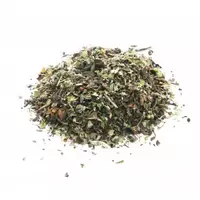Italian herbs

A characteristic feature of the cuisine of almost every region of Italy is the ability of local culinary experts to accurately arrange taste accents, due to which the traditional dishes of this country are characterized by some laconicity. This is even though almost any product is currently available - at any time of the year and anywhere. The maximum number of components in the recipe is no more than five to six, and chefs are not even going to deviate from this peculiar culinary rule.
In order to brighten the taste composition, they use other means - in particular, they use a large amount of all kinds of spices and spices, which occupy one of the leading places. However, to prepare a real dish of Italian cuisine, it is not enough just to season it with pepper and salt. The most common seasoning, most often used by local culinary geniuses and just hostesses, are Italian herbs. It's a blend of flavourful spicy herbs, perfectly tailored for their flavours, that work perfectly together to complement each other.
In addition, Italian herbs have long been loved and are in constant demand among culinary experts around the world. Giving the ready-made dishes a unique island-spicy aroma, they perfectly complement almost all the first and second dishes. The proportions and number of individual spices in the composition of Italian herbs can be selected arbitrarily - we can say that much depends on the preferences of the cook and the requirements of the recipe for preparing a specific dish.
So, Italian herbs are quite often used in Mediterranean, French and other world cuisines, where they are added when preparing lasagna, pizza, open pies and casseroles. Italian herbs are perfectly combined with all types of meat, as well as poultry, for example, chicken. Guests can be treated to an Italian steak at the festive table. This requires beef, onions, spinach, lime, olive oil, balsamic vinegar and, undoubtedly, a mixture of Italian herbs.
Quite often this seasoning is also added to a variety of soups, sauces and salads. Sometimes Italian herbs are simply indispensable when preparing minced meat, roast, some fillings and fish dishes. This aromatic mixture is recommended to be used for dressing not only fatty dishes, but also dietary ones - it will give a unique taste and diversify meals that should be eaten without salt.
Italian herbs are good in combination with any fresh greens, various types of peppers and onions. Sometimes this mixture is added to pastries: for example, you can bake potato bread with Italian herbs.
Composition of Italian herbs
Traditionally, Italian herbs include spices and spices such as oregano, basil, garlic, onion and chaber. Also, in this spicy mixture, shambhala leaves, dried lemongrass and crushed dry kafirlima leaves are often present.
Italian herbs 259.3 kCal
The energy value of Italian herbs (Ratio of proteins, fats, carbohydrates - ju):
Proteins: 12.368 (~ 49 kCal)
Fats: 6.508 g. (~ 59 kCal)
Carbohydrates: 25.978 g (~ 104 kCal)
Energy ratio (b | y): 19% | 23% | 40%
 Español
Español Français
Français Português
Português Русский
Русский 简体中文
简体中文 繁體中文
繁體中文 日本語
日本語 한국어
한국어 العربية
العربية Türkçe
Türkçe Қазақ
Қазақ Deutsch
Deutsch Italiano
Italiano Українська
Українська
